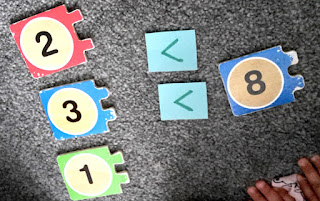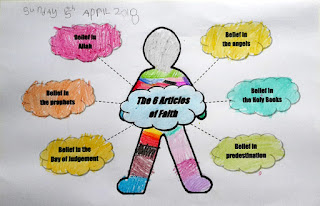[07] اَلْمُؤْمِنْ (Al-Mu'min): The Inspirer of Faith
 |
| Allah can make people be a Muslim. I can do an example and then people want to copy me but a good example like reading Quran or praying or maybe like say things in a gentle voice. |
Sing 99 Names (5min)
Play PowerPoint of the first 33 names, 2-3 times. Sing together and do the actions so far plus:
Action for Al-Mu'min: Touch your finger to your forehead then bring the hand down to chop the open palm of your other hand.
Today’s focus is on the name Al-Mu'min which means The Inspirer of Faith.
Story relating to today's name (7min)
Read a short story to the children: story of Umar (RA) converting to Islam (e.g. from a book such as Goodnight Stories From The Life Of The Prophet Muhammad).
Emphasise how the Muslims were practising Islam in secret before then, in fear of being hurt by the Quraysh. Point out how strong Umar (RA) was and how angry he was people were becoming Muslims - would the children feel scared of him if he was their enemy? How did his sister react when he came to their house? Was she brave? Did it seem likely Umar (RA) was going to accept Islam? But Allah can do anything and put faith in anyone's heart, even if we don't expect it. How do the children think the Muslims felt knowing that Umar (RA) was on their side now?
Emphasise how the Muslims were practising Islam in secret before then, in fear of being hurt by the Quraysh. Point out how strong Umar (RA) was and how angry he was people were becoming Muslims - would the children feel scared of him if he was their enemy? How did his sister react when he came to their house? Was she brave? Did it seem likely Umar (RA) was going to accept Islam? But Allah can do anything and put faith in anyone's heart, even if we don't expect it. How do the children think the Muslims felt knowing that Umar (RA) was on their side now?
Discuss meaning, apply to children's lives (20min)
Al-Mu'min means The Inspirer of Faith. It has other meanings too, such as "The One Who Believes" and "The Giver of Security", but we're going to focus on how He is The Inspirer of Faith today.
Do you know what "faith" means? In Arabic, we call it "imaan". (If children have covered the 6 articles of faith, link to that aspect). Having faith in something means to believe or to know that it's true, even if you can't see or hear (or use any of your senses!) to prove it. It's easy to have faith in things we can prove or have experienced before, e.g. do you believe it will be dark tonight and the sun will go down? Yes? Why? Because it's happened before and you've seen it? Do you believe that you used to be a baby? Yes? Because you've seen photos of yourself? Do you believe you'll be an adult one day, insha'Allah? Why? Because you've seen how babies grow up?
It's harder to believe in things you can't see - that needs more faith to do. Play falling back game for parent to catch child, i.e. child stands in front and closes eyes, then needs to fall backwards and trust their parent won't let them fall on the floor! Do a couple of times. Did it become easier to have faith each time? Why? Because you didn't fall the first time so you found it easier to trust you wouldn't fall the next! Just as the more we learn about Islam, remember Allah (SWT) and the more we practise the things we should do, e.g. praying, reading Quran, making du'aa, etc., the stronger our imaan becomes.
What does "inspire" mean? It means to make someone else want to do something or give them the idea to do something. We can feel inspired by other people by what they say or do, and our words and actions can inspire others to do good or bad too. Watch an inspirational YouTube clip or one which gives an example of inspiration, e.g. Animation- Never give up (What did the dog inspire the boy to do? Go outside. Why? Because they were both missing one leg) When we inspire others to do good, we get reward for it too. If someone does something bad because of it, then we're to blame for their bad actions too. (If children are familiar with the story Have You Filled A Bucket Today, remind them of this; or save to do as an activity another day).
Allah is Al-Mu'min, so only He is in control of who believes in Islam or not. You might see people e.g. in the masjid who pray a lot or recite beautiful Quran - but you don't know what's in their hearts or if they might go astray, so you shouldn't be jealous but just make du'aa for them: MashaAllah. You might see someone who never prays and is rude - but you don't know if/when Allah might guide them and they may become an even better Muslim than you! So you should never judge other people but instead focus on yourself. You should do your best to just be the best Muslim you can and try to inspire others to want to copy you.
It's harder to believe in things you can't see - that needs more faith to do. Play falling back game for parent to catch child, i.e. child stands in front and closes eyes, then needs to fall backwards and trust their parent won't let them fall on the floor! Do a couple of times. Did it become easier to have faith each time? Why? Because you didn't fall the first time so you found it easier to trust you wouldn't fall the next! Just as the more we learn about Islam, remember Allah (SWT) and the more we practise the things we should do, e.g. praying, reading Quran, making du'aa, etc., the stronger our imaan becomes.
What does "inspire" mean? It means to make someone else want to do something or give them the idea to do something. We can feel inspired by other people by what they say or do, and our words and actions can inspire others to do good or bad too. Watch an inspirational YouTube clip or one which gives an example of inspiration, e.g. Animation- Never give up (What did the dog inspire the boy to do? Go outside. Why? Because they were both missing one leg) When we inspire others to do good, we get reward for it too. If someone does something bad because of it, then we're to blame for their bad actions too. (If children are familiar with the story Have You Filled A Bucket Today, remind them of this; or save to do as an activity another day).
Allah is Al-Mu'min, so only He is in control of who believes in Islam or not. You might see people e.g. in the masjid who pray a lot or recite beautiful Quran - but you don't know what's in their hearts or if they might go astray, so you shouldn't be jealous but just make du'aa for them: MashaAllah. You might see someone who never prays and is rude - but you don't know if/when Allah might guide them and they may become an even better Muslim than you! So you should never judge other people but instead focus on yourself. You should do your best to just be the best Muslim you can and try to inspire others to want to copy you.
Craft activity (15min)
Complete the page for the book.
Colour in the titles and the picture - it shows a person covering their ears and closing their eyes but is still happy and full of love, to show having belief even when you can't hear or see something. Stick shiny paper/use glitter on the rays of light in the background and introduce idea of "nur" (light) as a representation of imaan.
When to use this name (8min)
When you're feeling sad or maybe even unsure about Islam (maybe reading the Quran is difficult or you don't like stopping playing to pray, it's ok to have these feelings sometimes) - trust in Allah. Remind yourself of all His blessings and the reason you're obeying Him. Make du'aa to Al-Mu'min to make your faith strong again.
When you're feeling happy about being a Muslim and everything is going well (e.g. you've just learnt a new surah!), don't take it for granted. Thank Allah for guiding you to Islam and giving you the chance to fill your book with good deeds. Make du'aa to Al-Mu'min to inspire others to feel closer to Him too.
When you're feeling happy about being a Muslim and everything is going well (e.g. you've just learnt a new surah!), don't take it for granted. Thank Allah for guiding you to Islam and giving you the chance to fill your book with good deeds. Make du'aa to Al-Mu'min to inspire others to feel closer to Him too.
On the back of their page, help the children write a few thoughts about the name Al-Mu'min and their feelings.
Sticker chart (5min)
Ask individually: Which of Allah’s names did we learn today? What does it mean? Give children a sticker each for their chart.
----------
Other activities:
- Different levels of faith in Muslims - stronger believers are called "mu'mins" - someone who not only listens to Allah's commands but acts upon them too. When you truly believe in something it should affect your behaviour and the way you act, the decisions you make, etc. too. It's being happy when something good happens and knowing it came from Allah, "Alhamdulillah"; it's also being patient when something bad happens and understanding it also came from Allah, "SubhanAllah" - it's having faith that Allah is the best of planners and all things happen for a reason. Activity: On the front of a small piece of coloured card write something good which happened recently and the word "Alhamdulillah" underneath in colourful writing. On the back of the card, write something bad which happened recently and the word "SubhanAllah" underneath in colourful writing. Draw a picture on each side too, if they wish. Holepunch the top and holepunch a piece of A4 card then tie the two together using a piece of ribbon.
- Read a story such as "Have You Filled a Bucket Today" and do a related craft activity, e.g. filling their own bucket (A4 card template or decorating an old jar) with stars (coloured card cut-outs, either stick on/put inside bucket) - on each star, write a way in which you could fill someone's bucket, e.g. acts of kindness, smiling, helping with something, etc... Things which would inspire others to do good, too. Discuss potential ways of emptying someone's bucket, i.e. things to avoid doing as they can upset people or inspire others to do bad things too. Finish on a positive by reading through their stars again and praising them for trying their best to do good.


































